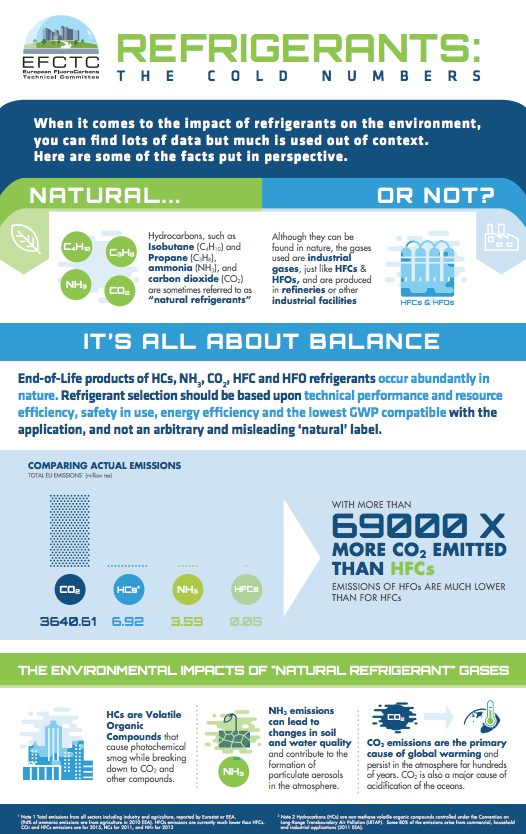Refrigerants Compared
Refrigerants
the cold numbers
When it comes to the impact of refrigerants on the environment, you can find lots of data but much is used out of context. Here are some of the facts put in perspective.
Natural…
Or not?
It’s all about balance
End-of-Life products of HCs, NH3, CO2, HFC and HFO refrigerants occur abundantly in nature. Refrigerant selection should be based upon technical performance and resource efficiency, safety in use, energy efficiency and the lowest GWP compatible with the application, and not an arbitrary and misleading ‘natural’ label.
COMPARING ACTUAL EMISSIONS
TOTAL EU EMISSIONS 1 (million te)
WITH MORE THAN
69000 x
MORE CO2 EMITTED
THAN HFCs
EMISSIONS OF HFOs ARE MUCH LOWER THAN FOR HFCs
THE ENVIRONMENTAL IMPACTS OF “NATURAL REFRIGERANT” GASES
CO2 emissions are the primary cause of global warming and persist in the atmosphere for hundreds of years. CO2 is also a major cause of acidification of the oceans.
THE ENVIRONMENTAL IMPACT OF HFCs & HFOs BREAKDOWN PRODUCTS
All of the final breakdown products of fluorocarbon refrigerants, already occur in nature in very large quantities and so HFCs & HFOs have little impact.
What
are
they?
Do These
Occur
Naturally?
Yes. Formic acid occurs naturally in the atmosphere. Fluoride is found all over the globe and is naturally transported by winds.
What
About
TFA?
Over 200 million tonnes of TFA are present naturally in both coastal and deep-ocean seawater. HFCs and HFOs will add only 0.1% to the amounts already naturally present.
Refrigerant Production
Manufacturing all refrigerant gases requires energy due to their production processes.
Globally most CO2 is used for Enhanced Oil Recovery (EOR, fracking) mainly in the USA (Global CCS Institute). Other main applications are beverage carbonisation and food industry usage.
HCs (LPG) are used mainly as fuel and also as aerosol propellants and for foam blowing.
production of other chemicals including fertilizers
HFCs are used as the propellant in MDIs for asthma treatment and for foam blowing.
HFOs are used for foam blowing and technical aerosols.
